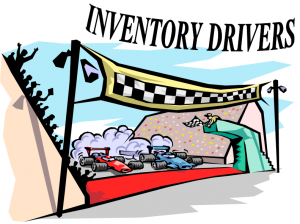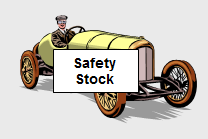 There are three different types of Lead Time all of which affect Inventory Levels in similar but different ways. The three types are Inbound, Internal and Outbound lead-time. Each of these can in turn be broken down to other types of lead time which again affects Inventory levels. In this posting I want to concentrate on Outbound Lead time because one aspect of it defines most of the effect all the types of lead-time will have on inventory levels. Specifically, the customer sets the lead time they are willing to wait to receive material once an order has been placed. The standard joke is that all customers want to receive their orders the day before they place the order but in fact, acceptable lead time is very dependent on the industry you are looking at. For instance, things like office supplies or cleaners can and usually are delivered the same day but nobody would expect to be able to order a new airplane for delivery the same day (maybe not the same year). The more customized a product is, the longer the accepted lead time for that product. How long the customer is willing to wait for their order will, to a large extent, define how much and what type of inventory a supplier must have. If the customer expects same day delivery then you must keep finished goods on hand at levels higher than the usage rate. As acceptable lead time grows longer the type of inventory will shift from finished goods to componentry to raw materials to on demand inventory. This has a direct effect on Inventory Value as the cost of inventory goes up as it moves from raw material to finished goods. In the end this means that the shorter the acceptable lead time the higher your inventory costs are likely to be.
There are three different types of Lead Time all of which affect Inventory Levels in similar but different ways. The three types are Inbound, Internal and Outbound lead-time. Each of these can in turn be broken down to other types of lead time which again affects Inventory levels. In this posting I want to concentrate on Outbound Lead time because one aspect of it defines most of the effect all the types of lead-time will have on inventory levels. Specifically, the customer sets the lead time they are willing to wait to receive material once an order has been placed. The standard joke is that all customers want to receive their orders the day before they place the order but in fact, acceptable lead time is very dependent on the industry you are looking at. For instance, things like office supplies or cleaners can and usually are delivered the same day but nobody would expect to be able to order a new airplane for delivery the same day (maybe not the same year). The more customized a product is, the longer the accepted lead time for that product. How long the customer is willing to wait for their order will, to a large extent, define how much and what type of inventory a supplier must have. If the customer expects same day delivery then you must keep finished goods on hand at levels higher than the usage rate. As acceptable lead time grows longer the type of inventory will shift from finished goods to componentry to raw materials to on demand inventory. This has a direct effect on Inventory Value as the cost of inventory goes up as it moves from raw material to finished goods. In the end this means that the shorter the acceptable lead time the higher your inventory costs are likely to be.
The other main aspect about outbound inventory is the logistics of moving from point A to B. Let’s take the case of a customer that expects same day delivery. They place an order and you have plenty in stock. No problem, you can accept the order. But hold on a minute; they want the material delivered to Vancouver and your stock is in Toronto. The only way you can deliver within 24 hours is to ship by air but that is too costly. You can ship by truck but that means 7 day in transit which the customer will not accept. For you to regularly service this customer properly you are going to have to create a secondary warehouse in the Vancouver area with all the attendant extra costs and increased inventory levels. This raises the question of whether there is enough business in the Vancouver area to support these extra costs. Again, the acceptable lead time is affecting your inventory levels and costs. There are a number of different ways to move your stock but they all have different cost and time profiles. These cost profiles need to be balanced against the cost of inventory and secondary warehouses. Finally, all this needs to be balanced against customer requirements and the competitive environment you sell in. (Is there a competitor active in the Vancouver area or will you have it all to yourself for a time). Each of these considerations and decisions will tend to push inventory levels higher or lower depending on how you chose to meet the requirements.
One thing that is certain about all this is that a large part of the discussion and decision process is more strategical than tactical. You are setting limits on what markets you are willing and able to pursue, on capital expenditure you are willing to make, on logistical structures and distribution channels that you are willing to use. These are all strategic decisions. Once they are made then you can move on to the more traditional tactical decisions. And all these decisions are required due to customer acceptable lead time. Far from being a straight forward discussion of keeping inventory lower than a specific value, Inventory Management at this level is a very tangled web with all the various factors interacting with each other. It actually may turn out to be cheaper to carry more inventory but reduce logistical time and costs. Again, this goes back to an earlier blog that the only reason to have inventory is if it is cheaper to have it than not have it. In this case the cost of the inventory is less than the logistics cost created by not carrying the extra inventory.
Next posting we will explore the effects caused by inbound lead time. In the meantime, enjoy thinking about this topic. Talk to your friends and co-workers about their experience and thoughts on this topic, especially what it means for your organization. And, as always, I would love to hear back on your (and their) thoughts.

